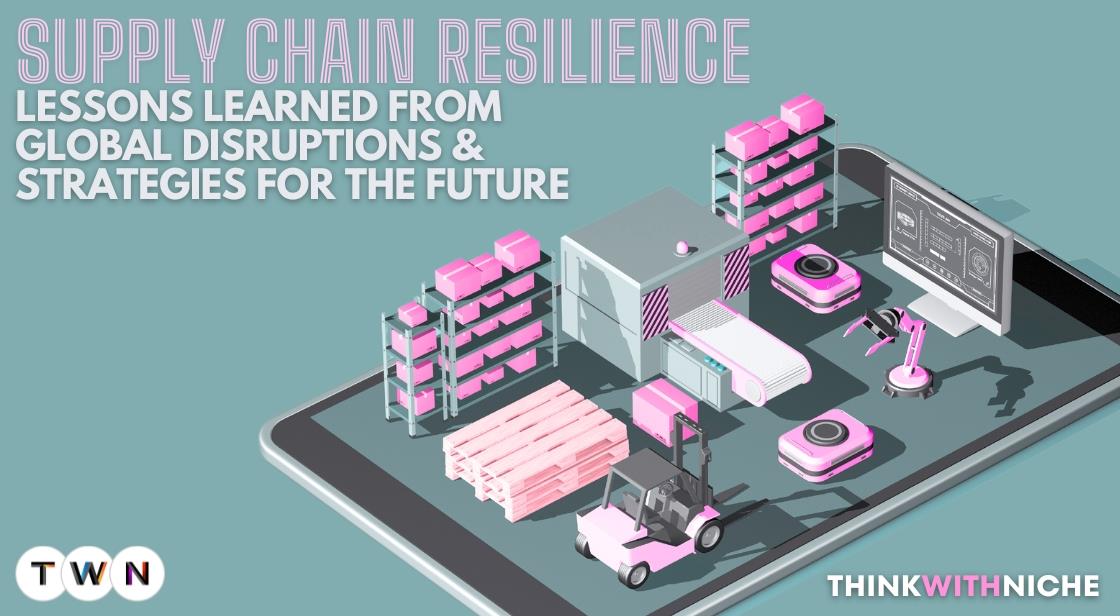Supply Chain Resilience: Lessons Learned from Global Disruptions and Strategies for the Future

Blog Post
In an era marked by unprecedented global disruptions, the resilience of supply chains has emerged as a critical determinant of business continuity and success. From natural disasters to geopolitical tensions and pandemics, various events have underscored the vulnerability of supply chains to unforeseen challenges. However, amidst these adversities lie invaluable lessons and opportunities for growth.
The topic of "Supply Chain Resilience: Lessons Learned from Global Disruptions and Strategies for the Future" delves into the evolving landscape of supply chain management, exploring the profound impact of past disruptions and unveiling strategies to fortify supply chains for the future.
Global disruptions such as the COVID-19 pandemic have brought supply chain vulnerabilities to the forefront, exposing dependencies on single-source suppliers, prolonged lead times, and limited inventory buffers.
As businesses grappled with supply shortages, production halts, and distribution bottlenecks, the imperative for resilient supply chains became unmistakably clear.
Yet, amidst these challenges, organizations have gleaned invaluable insights into the resilience-enhancing measures necessary to weather future storms. From diversifying sourcing locations and suppliers to leveraging advanced technology for real-time visibility and predictive analytics, companies are actively reevaluating and fortifying their supply chain strategies.
Moreover, collaborative partnerships, agile processes, and robust risk management frameworks have emerged as linchpins in fostering supply chain resilience. By cultivating flexibility, adaptability, and responsiveness, businesses can proactively navigate disruptions, minimize disruptions, and seize opportunities for innovation and growth.
As we navigate an increasingly complex and uncertain global landscape, the lessons learned from past disruptions serve as guiding beacons, illuminating pathways toward a more resilient and agile supply chain ecosystem.
This article explores these lessons in-depth, offering actionable insights and strategies to future-proof supply chains and ensure enduring success in the face of adversity.
Navigating Supply Chain Challenges: Insights and Strategies for Resilience
1. Understanding Supply Chain Disruptions
Understanding these dynamics is crucial for organizations seeking to build resilient supply chains capable of withstanding future disruptions. By identifying vulnerabilities, developing contingency plans, and fostering collaboration with suppliers and partners, businesses can mitigate the impact of disruptions and ensure continuity of operations.
Overview of Recent Global Disruptions:
-
Recent years have witnessed an array of global disruptions, ranging from natural disasters to pandemics and geopolitical tensions.
-
These disruptions have reverberated across supply chains worldwide, causing widespread disruptions to production, distribution, and logistics.
-
Examples include the COVID-19 pandemic, which led to factory closures, labor shortages, and transportation challenges, and natural disasters such as earthquakes, hurricanes, and floods, which disrupted manufacturing facilities and transportation networks.
Impact of Natural Disasters and Pandemics:
-
Natural disasters, including earthquakes, hurricanes, and floods, have the potential to damage infrastructure, disrupt transportation networks, and halt production activities.
-
Pandemics, such as the COVID-19 outbreak, pose unique challenges by disrupting labor availability, disrupting international trade, and causing demand fluctuations.
-
These disruptions often cascade throughout the supply chain, leading to inventory shortages, delayed deliveries, and increased costs.
Vulnerabilities Exposed in Global Supply Chains:
-
Recent disruptions have exposed vulnerabilities inherent in global supply chains, including over-reliance on single-source suppliers and geographically concentrated manufacturing hubs.
-
Just-in-time inventory management practices, while efficient in normal circumstances, can exacerbate disruptions by leaving little buffer for unexpected events.
-
Lack of supply chain visibility and transparency can hinder timely response to disruptions, making it difficult to identify and mitigate risks before they escalate.
2. Lessons Learned from Past Disruptions
Identifying key challenges faced by businesses involves recognizing and understanding the various obstacles and hurdles that organizations encounter in their day-to-day operations and long-term strategies. These challenges can span across different areas such as market dynamics, technological advancements, regulatory changes, economic fluctuations, and competitive pressures.
By identifying these challenges, businesses can proactively devise strategies to address them, minimize their impact, and capitalize on opportunities for growth and innovation. Common challenges include market volatility, talent acquisition and retention, supply chain disruptions, digital transformation, regulatory compliance, and sustainability initiatives.
Through comprehensive analysis and strategic planning, businesses can navigate these challenges effectively and enhance their resilience in an ever-evolving business landscape.
Identifying Key Challenges:
-
Over-reliance on Single Sourcing: A dependence on a single supplier or a limited pool of suppliers in a specific region can leave businesses exposed to disruptions caused by natural disasters, political instability, or unexpected production halts.
-
Limited Visibility and Inventory Management: Insufficient visibility across the supply chain network can hinder proactive risk identification and effective response strategies. Limited inventory buffers leave businesses vulnerable to stockouts during disruptions.
-
Inflexible Manufacturing Processes: Rigid production processes struggle to adapt to sudden shifts in demand or raw material shortages.
Strategies Employed to Mitigate Disruptions:
-
Supply Chain Diversification: Spreading sourcing locations and suppliers across different regions reduces dependency on any single point of failure and mitigates geopolitical risks. This can involve near-shoring or on-shoring critical production facilities closer to consumer markets.
-
Technology Adoption: Embracing real-time data visibility tools, predictive analytics, and advanced inventory optimization software allows companies to anticipate potential disruptions, optimize inventory levels, and make informed sourcing decisions. Blockchain technology can further enhance transparency and traceability within the supply chain network.
-
Agile Manufacturing: Developing flexible and adaptable production processes allows businesses to respond swiftly to changing market conditions and demand fluctuations. This might involve adopting modular product designs, implementing just-in-time manufacturing with safety stock buffers, and upskilling the workforce for rapid production line reconfiguration.
-
Collaboration and Partnerships: Building strong relationships with suppliers, logistics providers, and other stakeholders fosters better information sharing, resource pooling, and coordinated responses during disruptions. Collaborative planning, forecasting, and replenishment (CPFR) practices can enhance supply chain efficiency and agility.
Also Read: How Technology is Redefining Transportation Industry: Revolution on the Road
Case Studies in Resilience: Building on Best Practices
Example 1: Ford's Response to the Chip Shortage:
The global semiconductor shortage that began in 2020 significantly impacted the automotive industry. Ford, however, was able to navigate the crisis relatively unscathed due to its existing supplier relationships and risk management strategies. The company had maintained open communication with chip suppliers and adjusted production schedules proactively, allowing them to prioritize critical components for essential vehicle models.
Example 2: Walmart's Investment in Omnichannel Fulfillment:
Walmart's robust omnichannel fulfillment network, encompassing physical stores, distribution centers, and a strong online presence, proved advantageous during the COVID-19 pandemic. The company's investments in technology and automation enabled them to efficiently shift resources and fulfill online orders seamlessly, even as in-store shopping patterns fluctuated.
By studying successful cases like these, businesses can glean valuable insights into building robust and adaptable supply chains. Analyzing past disruptions and identifying key challenges allows companies to develop proactive strategies that enhance resilience and ensure long-term business continuity.
Example 4: Nestlé's Commitment to Sustainable Sourcing:
Nestlé's focus on sustainable sourcing practices helps them build a more resilient supply chain. They work with farmers to implement sustainable agricultural practices, which can mitigate risks associated with climate change and resource depletion.
Looking Ahead: Building a More Resilient Future
The future of supply chain management will likely be shaped by:
-
Increased automation and robotics: Automating repetitive tasks and leveraging robotics for warehouse operations can improve efficiency and reduce human error, particularly in environments with high potential for disruption.
-
Investment in Artificial Intelligence (AI) and Machine Learning (ML): AI and ML can be used to analyze vast amounts of supply chain data, identify potential risks, predict disruptions, and make real-time adjustments to optimize logistics and resource allocation.
-
Focus on Sustainability: Building a sustainable supply chain involves not only environmental considerations but also social responsibility practices. This includes ethically sourcing materials, ensuring fair labor practices throughout the supply chain network, and minimizing the environmental impact of transportation and logistics activities.
By adopting these strategies and staying ahead of emerging trends, businesses can navigate the complexities of the global marketplace and build supply chains that are not only efficient but also adaptable, responsive, and prepared for future disruptions.
3: Building Resilient Supply Chains
In today's dynamic and unpredictable business environment, the imperative of building resilient supply chains cannot be overstated. Resilience is not just about surviving disruptions but thriving in the face of adversity. It involves anticipating and preparing for potential risks, rapidly adapting to unforeseen challenges, and bouncing back stronger than before.
Key components of resilient supply chains include robust risk management frameworks, agile processes and operations, diversified sourcing strategies, advanced technology adoption, collaborative partnerships, and continuous improvement initiatives.
By integrating these components into their supply chain strategies, organizations can enhance their ability to withstand disruptions, minimize downtime, maintain customer satisfaction, and seize opportunities for growth and innovation.
Ultimately, resilient supply chains serve as a strategic asset, enabling businesses to navigate uncertainty, maintain competitiveness, and achieve long-term success in today's volatile business landscape.
Key Components of Supply Chain Resilience:
-
Diversification: Diversifying sourcing locations, transportation modes, and suppliers reduces dependency on single points of failure and enhances flexibility to adapt to disruptions.
-
Inventory Optimization: Balancing inventory levels to meet demand fluctuations while minimizing excess stock helps mitigate supply chain disruptions and reduce costs.
-
Risk Management: Implementing robust risk management frameworks to identify, assess, and mitigate potential risks proactively ensures readiness to respond to unforeseen events.
-
Agility and Flexibility: Building agile and flexible supply chains enables rapid response to changes in demand, supply, or market conditions, enhancing resilience against disruptions.
Investing in Technology and Digitalization:
-
Real-Time Visibility: Leveraging technologies such as IoT sensors, RFID, and blockchain provides real-time visibility into supply chain operations, enabling proactive monitoring and decision-making.
-
Predictive Analytics: Harnessing data analytics and AI-driven predictive models helps anticipate potential disruptions, enabling proactive risk mitigation and scenario planning.
-
Automation: Automating repetitive tasks and processes streamlines operations, reduces lead times, and enhances responsiveness to changes, improving supply chain resilience.
Strengthening Relationships with Suppliers and Partners:
-
Collaborative Partnerships: Fostering collaborative partnerships with suppliers and logistics partners promotes information sharing, mutual support, and coordinated response during disruptions.
-
Supplier Diversity: Cultivating relationships with a diverse pool of suppliers reduces dependency on a single source, mitigating the impact of supplier disruptions.
-
Transparency and Communication: Establishing open and transparent communication channels fosters trust and enables early detection and resolution of issues, strengthening supply chain resilience.
By focusing on these key components and strategies, organizations can build resilient supply chains capable of navigating uncertainties and disruptions while maintaining operational efficiency and customer satisfaction.
4: Future Strategies for Supply Chain Resilience
Future strategies for supply chain resilience encompass a proactive approach to anticipate and mitigate potential disruptions. Implementing predictive analytics and robust risk management systems enables organizations to identify and address vulnerabilities before they escalate.
Diversifying suppliers and geographic locations reduces dependency on single sources, enhancing resilience to localized disruptions. Moreover, fostering flexibility and agility in supply chain operations enables rapid response and adaptation to changing conditions.
This involves designing adaptable processes, leveraging digital technologies, and nurturing a culture of innovation and collaboration. By embracing these future-focused strategies, businesses can strengthen their supply chains, ensuring continuity, efficiency, and competitiveness in an increasingly dynamic and uncertain global landscape.
Implementing Predictive Analytics and Risk Management:
-
Leveraging predictive analytics tools allows companies to anticipate potential disruptions in the supply chain before they occur.
-
By analyzing historical data, market trends, and external factors, organizations can identify patterns and signals that indicate impending risks.
-
Predictive analytics enable proactive decision-making, such as adjusting inventory levels, reallocating resources, or rerouting shipments, to mitigate the impact of disruptions.
-
Coupled with robust risk management strategies, predictive analytics empower businesses to identify, assess, and prioritize risks across the supply chain.
-
Implementing risk management frameworks involves conducting thorough risk assessments, establishing contingency plans, and continuously monitoring and updating risk profiles to ensure resilience in the face of evolving threats.
Diversification of Suppliers and Geographic Locations:
-
Relying on a single-source supplier or geographic location exposes businesses to heightened risk in the event of disruptions such as natural disasters, geopolitical tensions, or trade restrictions.
-
Diversification involves sourcing materials and components from multiple suppliers across different regions or countries.
-
By diversifying suppliers and geographic locations, companies can minimize dependency on any single entity or location, thereby reducing vulnerability to localized disruptions.
-
Additionally, diversification enhances supply chain flexibility, enabling organizations to quickly adapt sourcing strategies in response to changing market dynamics or unforeseen events.
-
However, diversification requires careful supplier selection, rigorous qualification processes, and robust supplier relationship management to ensure consistent quality, reliability, and responsiveness across the supply base.
Flexibility and Agility in Supply Chain Operations:
-
Building flexibility and agility into supply chain operations enables rapid response and adaptation to changing conditions or disruptions.
-
This entails designing adaptable processes, workflows, and infrastructure that can easily accommodate fluctuations in demand, supply, or external factors.
-
Agile supply chains prioritize responsiveness, collaboration, and iterative improvement, allowing organizations to quickly pivot in response to emerging challenges or opportunities.
-
Embracing digital technologies such as automation, robotics, and cloud-based systems enhances operational agility by streamlining processes, enhancing visibility, and enabling real-time decision-making.
-
Moreover, fostering a culture of innovation, continuous learning, and cross-functional collaboration empowers employees to identify and implement agile solutions, driving operational resilience and competitive advantage.
5: Technology Solutions for Supply Chain Resilience
In today's dynamic business environment, leveraging technology is essential for enhancing supply chain resilience and ensuring operational continuity. This section explores key technology solutions that empower organizations to strengthen their supply chains and navigate disruptions effectively.
Predictive Analytics:
Predictive analytics involves using historical data, machine learning algorithms, and statistical modeling techniques to forecast future events and trends.
By analyzing past performance and external factors, organizations can anticipate potential disruptions, such as supplier delays or demand fluctuations, and take proactive measures to mitigate their impact.
Predictive analytics enables companies to make informed decisions, optimize inventory levels, and allocate resources efficiently, thereby enhancing supply chain resilience.
Blockchain Technology:
Blockchain technology offers a decentralized and transparent ledger system that records transactions securely across a network of computers. By providing an immutable record of transactions, blockchain enhances supply chain visibility and traceability.
Organizations can track the movement of goods, verify product authenticity, and streamline processes such as procurement and payments. Additionally, blockchain facilitates trust and collaboration among supply chain partners, reducing the risk of fraud and errors.
Internet of Things (IoT):
The Internet of Things (IoT) involves connecting physical devices and sensors to the internet, enabling them to collect and exchange data.
In the context of supply chain resilience, IoT technologies such as RFID tags, GPS trackers, and temperature sensors provide real-time visibility into the location, condition, and status of goods in transit.
This enables proactive monitoring, timely interventions, and optimization of supply chain processes, ultimately enhancing resilience and responsiveness.
Cloud Computing:
Cloud computing offers scalable and flexible computing resources over the internet, enabling organizations to access data, applications, and services on-demand.
By migrating supply chain operations to the cloud, companies can improve collaboration, streamline communication, and enhance data accessibility. Cloud-based supply chain management systems provide real-time insights, facilitate collaboration with suppliers and partners, and support remote work capabilities, thereby bolstering supply chain resilience in an increasingly digital world.
Conclusion: Embracing Resilience for Future Success
Embracing resilience is paramount for ensuring future success in an ever-evolving business landscape. By proactively implementing strategies to anticipate and mitigate disruptions, organizations can fortify their supply chains and navigate challenges with agility and confidence. Whether through predictive analytics, diversified sourcing, or flexible operations, prioritizing resilience fosters adaptability and responsiveness to changing circumstances.
Moreover, resilience goes beyond mere survival; it cultivates a culture of innovation and continuous improvement, driving sustainable growth and competitive advantage. As businesses face increasing complexity and uncertainty, those that embrace resilience as a guiding principle will emerge stronger, more adaptable, and better equipped to thrive in the face of adversity.
You May Like
EDITOR’S CHOICE












